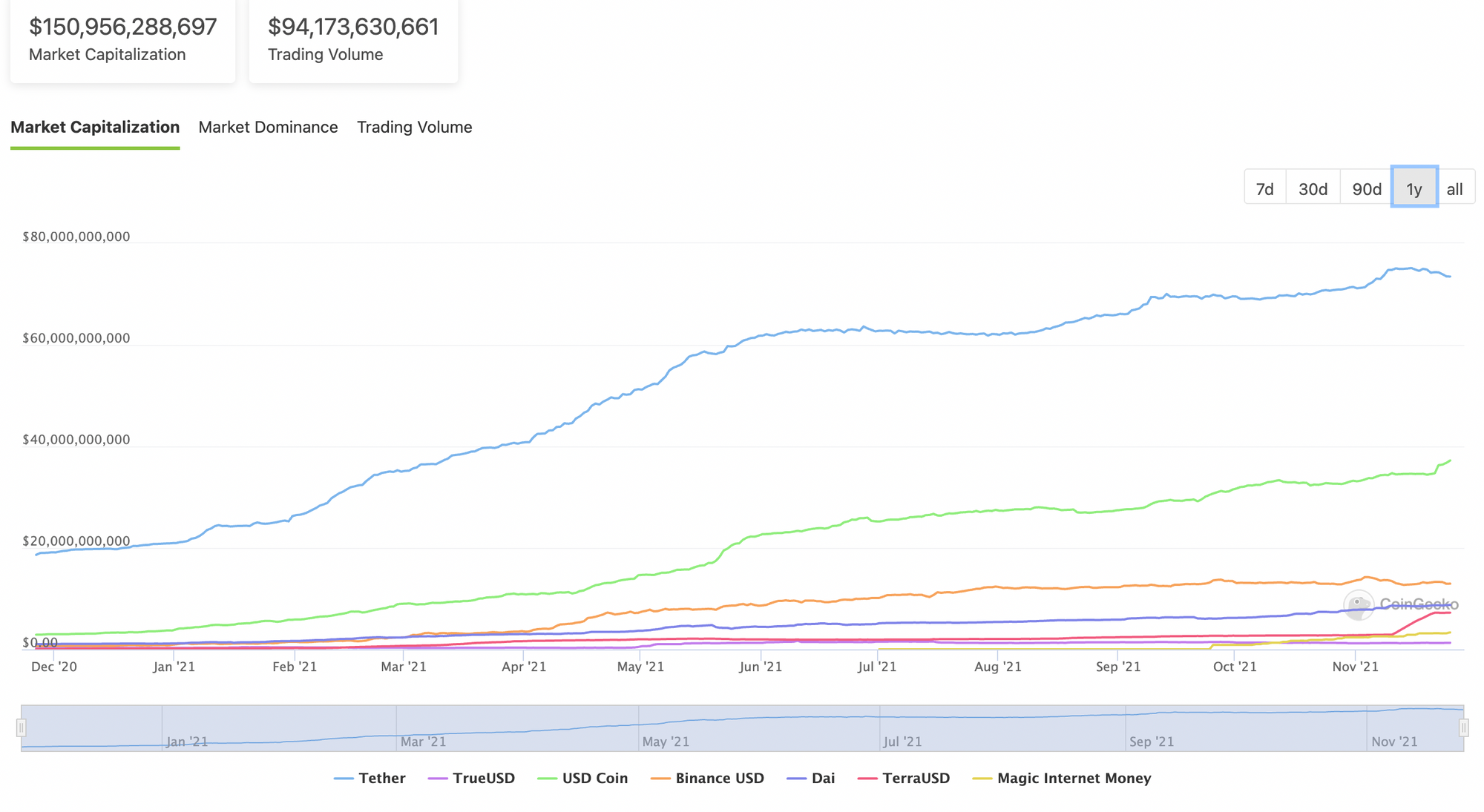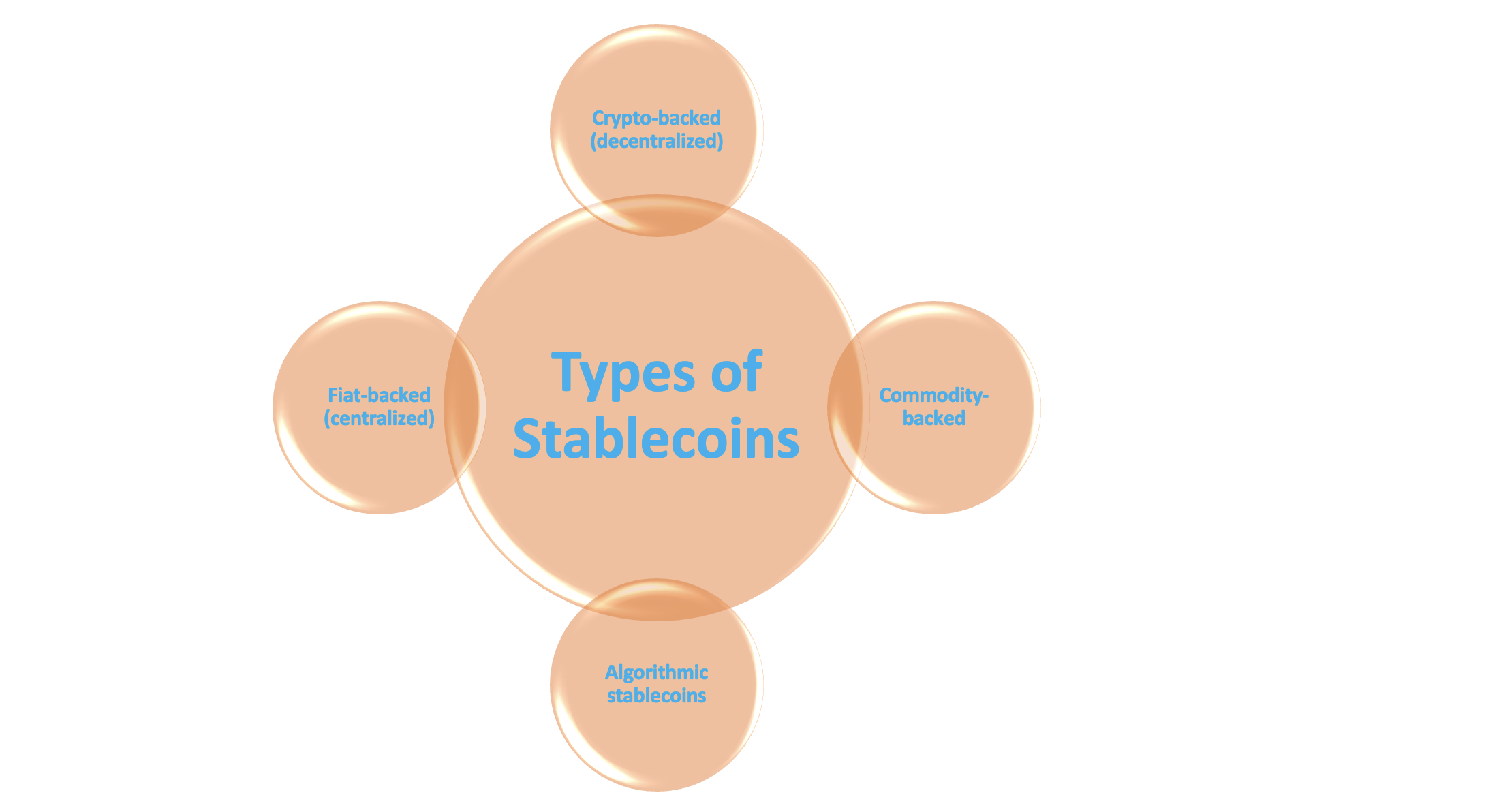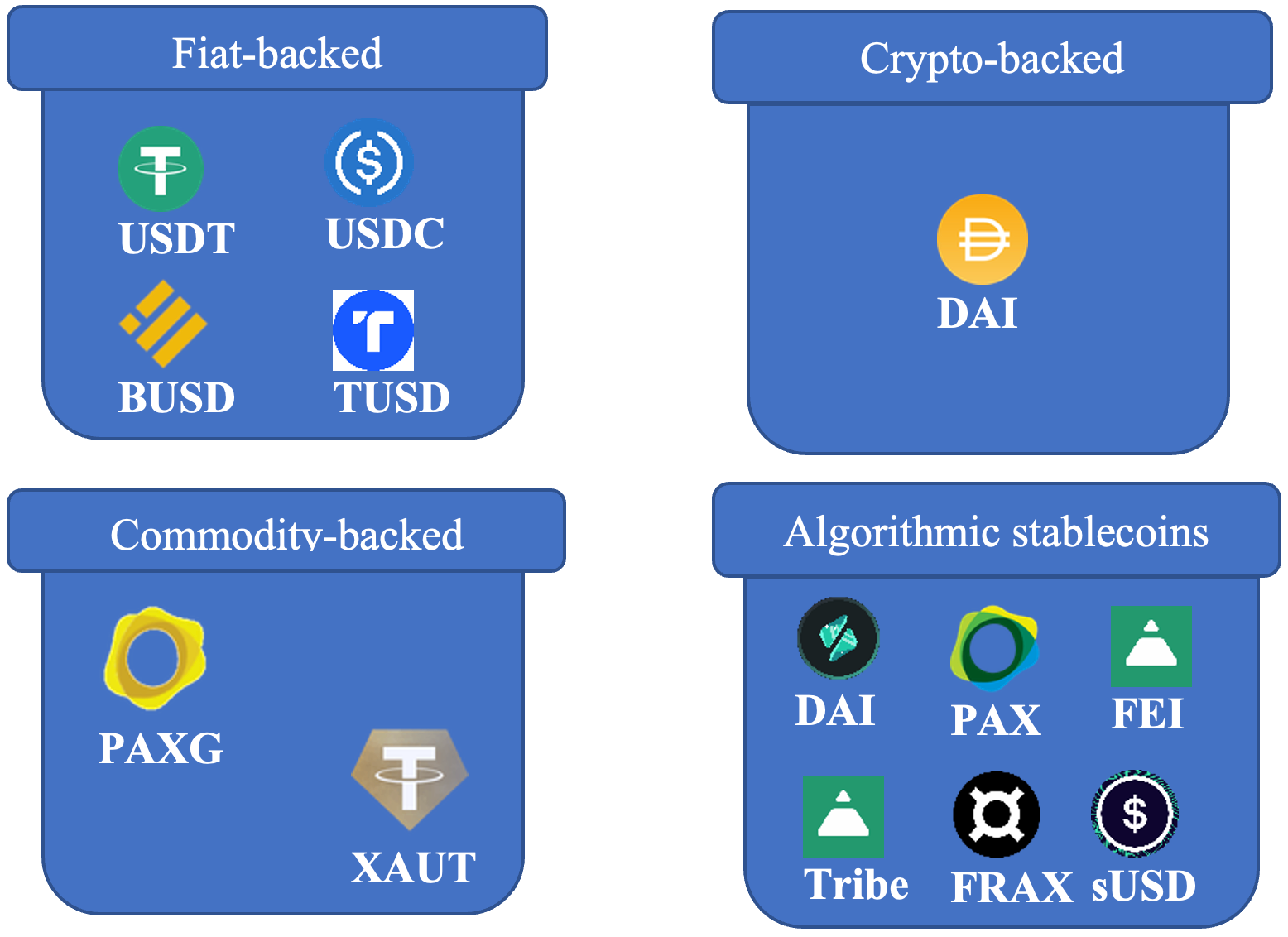Key takeaways:
- Stablecoins are a type of digital asset designed to maintain a stable value relative to a sovereign currency or other reference assets.
- There are four types of stablecoin: fiat-backed, crypto-backed, commodity-backed, and algorithmic stablecoin.
- Stablecoins are used in two most popular ways: participating DeFi projects and using them as a safe harbor to avoid crypto investing risks.
Understanding stablecoin
Cryptocurrency market tends to suffer from high volatility. For example, Bitcoin (BTC), the most dominant and widespread cryptocurrency, rose from around $5,000 at the height of the pandemic sell-off in March 2020 to almost $65,000 in April 2021 before plunging by over 50% to around $30,000 in June 2021. The price has since exceeded $65,000 in November 2021. Yet, BTC’s volatility can be sneezed at compared to that of some altcoins. This kind of volatility makes cryptocurrency unsuitable for everyday use by the public.
Fiat currencies maintain the price stabilities for two primary reasons: 1) they are backed by reserves, 2) their controlling authorities, for example, the central banks, make timely market actions to maintain the price stability. The bulk of cryptocurrencies lacks both features – they don’t have a reserve backing their value, and there are no central authorities to control the prices.
Stablecoins were born to bridge this gap between fiat currencies and cryptocurrencies. Stablecoins are a type of digital asset designed to maintain a stable value relative to a sovereign currency or other reference assets. They can be pegged to a cryptocurrency, fiat currency, exchange-traded commodities such as precious metals or industrial metals, or not pegged at all (algorithmic stablecoin). Fiat currency digital asset is the most popular use case for stablecoins. They typically track popular sovereign currencies such as the US Dollar, Euro, and the British Pound. The benefit of this includes being able to take advantage of blockchain technology and peer-to-peer value transfer while not being exposed to high volatility such as bitcoin, ethereum, or other cryptocurrencies.
Stablecoins can be thought of in two forms. Some serve as a "safe, liquid" asset in the decentralized finance, or DeFi. Alternatively, some stablecoins are intended to serve as an instrument for retail payments between consumers and firms. Although these types of stablecoins have not taken off yet, some firms are working to assess the viability of such stablecoins as a retail payment instrument. In this article, let’s look at the different types of stablecoins, how they work, and the most common ways they are used.
Stablecoin types

According to CoinGecko, the total market cap of stablecoins has exceeded $150 billion as of writing (Nov. 25, 2021), increasing almost fivefold in just the past year. CoinGecko has a list of 67 stablecoins, with the top 5 capping almost $140 billion, or over 93% of the total stablecoin market (top 5 being USDT, USDC, BUSD, DAI, and UST). Stablecoins can be identified by one of the four underlying collateral structures: fiat-backed, crypto-backed, commodity-backed, and algorithmic-stablecoin. Let’s dive into each of these primary types.

Fiat-backed
Fiat-collateralized stablecoins are the foremost variant of stablecoins users would come across. They are the simplest stablecoin types with a 1:1 ratio backing. The 1:1 ratio implies that one stablecoin would be equal to one unit of currency such as a dollar or one Euro. Therefore, every fiat-backed stablecoin has real fiat currency in a bank account for backing it up. Users can redeem their coins as the entity managing the stablecoin takes the corresponding amount of fiat currency from their reserve and sends it to the user’s bank account. At the same time, the equivalent amount of stablecoins is taken out of circulation or destroyed. Fiat-backed stablecoins are one of the simplest stablecoin categories due to their structural advantage. Simplicity offers the most valuable advantage for beginners to understand cryptocurrencies in a better way. Examples of Fiat-backed stablecoins include the largest cap stablecoin USD Tether (USDT), TrueUSD (TUSD), USD Coin, Diem, etc.
Crypto-backed
Crypto-backed stablecoins are issued with cryptocurrencies as collateral, which is conceptually similar to fiat-backed stablecoins. However, the significant difference between the two is that while fiat collateralization typically happens off the blockchain, the cryptocurrency or crypto asset used to back this type of stablecoins is done on the blockchain, using smart contracts in a more decentralized fashion. Another difference is that because the reserve cryptocurrency may also be prone to high volatility, such stablecoins are over-collateralized—that is, a larger number of cryptocurrency tokens is maintained as a reserve for issuing a lower number of stablecoins.
For example, one of the largest capped stablecoins - DAI, is issued by a decentralized protocol Maker as one of the first attempts at the crypto-backed stablecoins. The vaults are overcollateralized, generally 150% and above depending on the collateralized crypto. The collateralization ratio for Ether (ETH), for instance, is currently set at 150%, or in other words, depositing $150 worth of ETH allows one to mint up to 100 Dai, worth roughly $100.
The most crucial characteristic of this type of stablecoin is decentralization. Crypto-backed stablecoins could help processes become trustless with improved security and better transparency. Without any single entity in control of funds, one has the benefit of decentralization. The drawbacks of crypto-backed stablecoins are obvious too. Because they are usually over-collateralized, the capital efficiency can be low compared to other types of stablecoins.
Commodity-backed
Commodity-backed stablecoins have their value fixed to one or more commodities, such as precious metals, industrial metals, oil, or real estate. They are redeemable, meaning there is a promise to pay real assets when holders of the stablecoin want to redeem their coins. Compared to other types of stablecoins, this type has the cost of storing and insuring for the commodity backing.
Commodity-backed stablecoins facilitate investments in assets that may otherwise be out of reach locally. For instance, in many regions, obtaining a gold bar and finding a secure storage location is complex and expensive. As a result, holding physical commodities like gold and silver isn’t always a realistic proposition. However, commodity-backed stablecoins also afford utility to those that want to exchange tokens for cash or take possession of the underlying tokenized asset. Gold is the most popular commodity to be collateralized. Tether Gold (XAUT) and Paxos Gold(PAXG) are two of the most liquid gold-backed stablecoins.
Algorithmic stablecoin
As its name implies, algorithmic stablecoins utilize algorithms to control the stablecoin’s market structure and the underlying economics. Algorithmic stablecoins can be thought of as an automated Federal Reserve, where instead of human-made decisions, pre-programmed code executes specific actions to control and influence the price. The supply of the tokens is managed by smart contracts. Similar to how central banks maintain the price stability of fiat currency, when the market price of the token falls, the smart contract will reduce the number of tokens in circulation. Alternatively, when the price of the token rises, new tokens will be issued and released into circulation to adjust the stablecoin value downward. With this mechanism, the value of the stablecoin can stay stable to the fiat currency it is pegged to. Algorithmic stablecoins don’t require other cryptocurrencies as collateral. Algorithmic stablecoins include FRAX, RAI, FEI, etc.

How do people use stablecoins?
Stablecoins are primarily used in two ways.
The most popular way that people use stablecoins is probably to participate in DeFi projects, such as crypto lending and borrowing, assets swapping, or derivative trading. DeFi applications use blockchain technology without intermediaries, thus leaving no access for fiat currencies or other tangible assets to participate in the usage. Stablecoins merged the utility of fiat currencies with cryptocurrencies by pegging each stablecoin’s value to another asset. By minimizing the volatility risk for users, stablecoins also make it easier for users to understand the cost or profit that can come from participating in DeFi applications.
The other popular way is that people use stablecoin as a safe harbor which allows them to reduce their risk to crypto assets without the need to leave the crypto ecosystem. For example, when markets are volatile, traders might sell their crypto and park it in treasures. However, they want to keep their money in the crypto system instead of changing them to fiat just so they can invest again when the timing is right. Stablecoin, in this case, can provide a safe place for the traders without exiting the cryptosystem. Holding the funds in a stablecoin mitigates the user’s risk. It's a bit like keeping cash in a brokerage account while waiting to invest.
The supply of stablecoins has been growing at an unprecedented rate and is expected to grow in the future. The overall volume of stablecoins is expected to continue increasing, especially with the explosive growth of DeFi in the past year. There’s a strong expectation that stablecoins will pave the way for cryptocurrencies to become mainstream. Moreover, with a huge unbanked and underbanked population globally, and people and businesses looking for faster, easier, and cheaper ways of sending payments across borders, stablecoins have huge growth potential.
Discover SynFutures' Crypto Derivatives products: www.synfutures.com/.
Disclaimer: SynFutures Academy does not guarantee the reliability of the site content and shall not be held liable for any errors, omissions, or inaccuracies. The opinions and views expressed in any SynFutures Academy article are solely those of the author(s) and do not reflect the opinions of SynFutures. The SynFutures Academy articles are for educational purposes or information only. SynFutures Academy has no relationship to the projects mentioned in the articles, and there is no endorsement for these projects. The information provided on the site does not constitute an endorsement of any of the products and services discussed or investment, financial, or trading advice. A qualified professional should be consulted prior to making financial decisions.


